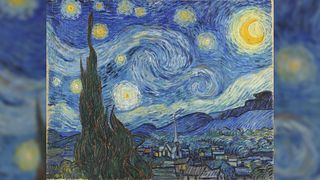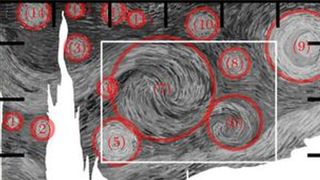Van Gogh’s ‘Starry Night’ contains surprisingly accurate physics — suggesting he understood the hidden ‘dynamism of the sky’

New research suggests there is more to Vincent van Gogh’s famous painting Starry Night than meets the eye. Its turbulent, swirling sky shares many characteristics with invisible fluid dynamics processes that occur in our real-world atmosphere, an analysis of the brushstrokes and colors in the painting reveals.
Van Gogh painted Starry Night in June 1889, while he was living in an asylum in southern France as he recovered from a mental breakdown that resulted in the self-mutilation of his left ear around six months earlier. The oil-on-canvas masterpiece shows the view of a swirling sky from the window of the painter’s room with an imaginary village added in the foreground, and is famous for its detailed brushstrokes and use of bright hues.
The painting recently caught the eye of researchers in China who recognized some similarities between its spiraling shapes and the patterns seen in fluid dynamics — the study of the movements of fluids and gases. This inspired them to study the painting in greater detail.
In the new study, published Tuesday (Sept. 17) in the journal Physics of Fluids, the researchers analyzed the minute details of the brushstrokes and colors used in the paintings and found that these components both shared strong similarities with the “hidden turbulence” of gases in the atmosphere.
“It reveals a deep and intuitive understanding of natural phenomena,” study co-author Yongxiang Huang, a fluid dynamics expert and oceanographer at Xiamen University in China, said in a statement. “Van Gogh’s precise representation of turbulence might be from studying the movement of clouds and the atmosphere or an innate sense of how to capture the dynamism of the sky.”
Related: Hidden Van Gogh self-portrait discovered under ‘peasant woman’ painting

The researchers closely analyzed the 14 “whirls” in the painting’s sky. Overall, these shapes generally followed patterns predicted by Kolmogorov’s law — a physical rule that describes how atmospheric gas moves at different scales depending on inertial energy. In the painting, that inertial energy is represented by the intensity of the yellows in the painting, the researchers wrote.
When the researchers looked more closely at the whirls, they also found the spacing and weight of individual brushstrokes revealed an alignment with Batchelor’s scaling, which describes how small eddies and droplets can be before they dissipate in a turbulent fluid.
However, Kolmogorov and Batchelor developed their laws decades after the artist died. So, the authors wrote, Van Gogh was definitely not using fluid dynamics knowledge, but likely drawing on general observations of the sky or other naturally occurring spirals as inspiration. Similarly, the connection between energy and the color yellow is almost certainly a coincidence, the authors noted.

But it’s clear that Starry Night evokes processes that crop up in the natural world.
In 2020, researchers named a new species of peacock spider after the painting due to a similarity between van Gogh’s colorful swirls and luminous dots on the arachnid’s rear end. And in 2021, microbiologists also noticed a striking similarity between the painting’s iconic swirls and swarming colonies of mutated bacteria.
In May this year, new photos of Jupiter from NASA‘s Juno probe also showed intense storm swirls in the planet’s northern hemisphere which looked very similar to van Gogh’s newly analyzed brushstrokes. These swirling clouds were also linked to “turbulent patterns” in Jupiter’s atmosphere, similar to those on Earth.
 Print
Print


